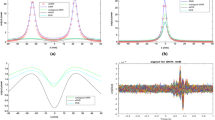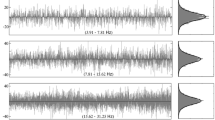Abstract
Adaptive and non-adaptive beamformers have become a prominent neuroimaging tool for localizing neural sources of electroencephalographic (EEG) and magnetoencephalographic (MEG) data. In this study, we investigated single-source and multi-source scalar beamformers with respect to their performances in localizing and reconstructing source activity for simulated and real EEG data. We compared a new multi-source search approach (multi-step iterative approach; MIA) to our previous multi-source search approach (single-step iterative approach; SIA) and a single-source search approach (single-step peak approach; SPA). In order to compare performances across these beamformer approaches, we manipulated various simulated source parameters, such as the amount of signal-to-noise ratio (0.1–0.9), inter-source correlations (0.3–0.9), number of simultaneously active sources (2–8), and source locations. Results showed that localization performance followed the order of MIA > SIA > SPA regardless of the number of sources, source correlations, and single-to-noise ratios. In addition, SIA and MIA were significantly better than SPA at localizing four or more sources. Moreover, MIA was better than SIA and SPA at identifying the true source locations when signal characteristics were at their poorest. Source waveform reconstructions were similar between MIA and SIA but were significantly better than that for SPA. A similar trend was also found when applying these beamformer approaches to a real EEG dataset. Based on our findings, we conclude that multi-source beamformers (MIA and SIA) are an improvement over single-source beamformers for localizing EEG. Importantly, our new search method, MIA, had better localization performance, localization precision, and source waveform reconstruction as compared to SIA or SPA. We therefore recommend its use for improved source localization and waveform reconstruction of event-related potentials.

Source reconstruction results regarding “observed” locations and waveforms were compared to the “true” source locations and waveforms. See main text for more detailed descriptions of the steps for the SPA, SIA, and MIA pathways and of the comparisons between “true” and “observed” source waveforms and locations









Similar content being viewed by others
References
Brookes MJ, Vrba J, Mullinger KJ, Geirsdóttir GB, Yan WX, Stevenson CM, Morris PG (2009) Source localisation in concurrent EEG/fMRI: applications at 7T. Neuroimage 45(2):440–452
Chai T, Draxler RR (2014) Root mean square error (RMSE) or mean absolute error (MAE)?—Arguments against avoiding RMSE in the literature. Geosci Model Develop 7(3):1247–1250
Dalal SS, Sekihara K, Nagarajan SS (2006) Modified beamformers for coherent source region suppression. IEEE Trans Bio-Med Eng 53(7):1357–1363. https://doi.org/10.1109/TBME.2006.873752
Dalal SS, Guggisberg AG, Edwards E, Sekihara K, Findlay AM, Canolty RT, Nagarajan SS (2008) Five-dimensional neuroimaging: localization of the time—frequency dynamics of cortical activity. Neuroimage 40(4):1686–1700
Dalal SS, Baillet S, Adam C, Ducorps A, Schwartz D, Jerbi K, Lachaux JP (2009) Simultaneous MEG and intracranial EEG recordings during attentive reading. Neuroimage 45(4):1289–1304
Darvas F, Pantazis D, Kucukaltun-Yildirim E, Leahy RM (2004) Mapping human brain function with MEG and EEG: methods and validation. NeuroImage 23:S289–S299
Diwakar M, Tal O, Liu TT, Harrington DL, Srinivasan R, Muzzatti L, Huang MX (2011) Accurate reconstruction of temporal correlation for neuronal sources using the enhanced dual-core MEG beamformer. Neuroimage 56(4):1918–1928
Haufe S, Ewald A (2016) A simulation framework for benchmarking EEG-based brain connectivity estimation methodologies. Brain Topogr. https://doi.org/10.1007/s10548-016-0498-y
Herdman AT, Cheyne D (2009) A practical guide for MEG and beamforming. Brain Sign Analysis: Advances in Neuroelectric and Neuromagnetic Methods, pp 99
Herdman AT, Takai O (2013) Paying attention to orthography: a visual evoked potential study. Front Human Neurosci 7:199
Herdman AT, Wollbrink A, Chau W, Ishii R, Ross B, Pantev C (2003) Determination of activation areas in the human auditory cortex by means of synthetic aperture magnetometry. NeuroImage 20:995–1005
Hillyard SA, Anllo-Vento L (1998) Event-related brain potentials in the study of visual selective attention. Proc Natl Acad Sci 95(3):781–787
Howell DC (2009) Statistical methods for psychology, Nelson Education
Hui HB, Pantazis D, Bressler SL, Leahy RM (2010) Identifying true cortical interactions in MEG using the nulling beamformer. NeuroImage 49(4):3161–3174
Jonmohamadi Y, Poudel G, Innes C, Weiss D, Krueger R, Jones R (2014) Comparison of beamformers for EEG source signal reconstruction. Biomed Signal Process Control 14:175–188
Matthews BW (1975) Comparison of the predicted and observed secondary structure of T4 phage lysozyme. Biochim Et Biophys Acta (BBA) 405(2):442. https://doi.org/10.1016/0005-2795(75)90109-9
Moiseev A, Herdman AT (2013) Multi-core beamformers: derivation, limitations and improvements. NeuroImage 71:135. https://doi.org/10.1016/j.neuroimage.2012.12.072
Moiseev A, Gaspar JM, Schneider JA, Herdman AT (2011) Application of multi-source minimum variance beamformers for reconstruction of correlated neural activity. NeuroImage. https://doi.org/10.1016/j.neuroimage.2011.05.081
Murzin V, Fuchs A, Kelso JS (2011) Anatomically constrained minimum variance beamforming applied to EEG. Exp Brain Res 214(4):515
Robinson SE, Vrba J (1999) Functional neuroimaging by synthetic aperture magnetometry (SAM). In: Yoshimoto T, Kotani M, Kuriki S, Karibe H, Nakasato N (eds) Recent advances in biomagnetism. Tohoku University Press, Sendai, pp 302–305
Sekihara K, Nagarajan SS (2008) Adaptive spatial filters for electromagnetic brain imaging Springer Science & Business Media, NewYork
Sekihara K, Nagarajan SS (2015) Electromagnetic brain imaging: a bayesian perspective, 1st edn. Springer, Switzerland
Sekihara K, Nagarajan SS, Poeppel D, Marantz A, Miyashita Y (2001) Reconstructing spatio-temporal activities of neural sources using an MEG vector beamformer technique. IEEE Trans Bio-Med Eng 48(7):760–771. https://doi.org/10.1109/10.930901
Sekihara K, Nagarajan SS, Poeppel D, Marantz A, Miyashita Y (2002) Application of an MEG eigenspace beamformer to reconstructing spatio-temporal activities of neural sources. Hum Brain Mapp 15(4):199–215
Sekihara K, Nagarajan S, Poeppel D, Marantz A (2004) Asymptotic SNR of scalar and vector minimum-variance beamformers for neuromagnetic source reconstruction. IEEE Trans Biomed Eng 51(10):1726–1734
Sekihara K, Sahani M, Nagarajan SS (2005) Localization bias and spatial resolution of adaptive and non-adaptive spatial filters for MEG source reconstruction. NeuroImage 25(4):1056–1067. https://doi.org/10.1016/j.neuroimage.2004.11.051
Tadel F, Baillet S, Mosher JC, Pantazis D, Leahy RM (2011) Brainstorm: a user-friendly application for MEG/EEG analysis. Comput Intell Neurosci 2011:8
Van Veen BD, Buckley KM (1988) Beamforming: a versatile approach to spatial filtering. IEEE Trans Signal Process 5:4–24
Van Veen BD, van Drongelen W, Yuchtman M, Suzuki A (1997) Localization of brain electrical activity via linearly constrained minimum variance spatial filtering. IEEE Trans Biomed Eng 44(9):866–880
Van Hoey G, Van de Walle R, Vanrumste B, D’Havse M, Lemahieu I, Boon P (1999) Beamforming techniques applied in EEG source analysis. Proc ProRISC99 10:545–549
Funding
Funding was provided by Natural Sciences and Engineering Research Council of Canada and University of British Columbia.
Author information
Authors and Affiliations
Corresponding author
Additional information
Handling Editor: Seppo P. Ahlfors.
Electronic Supplementary material
Below is the link to the electronic supplementary material.
Rights and permissions
About this article
Cite this article
Herdman, A.T., Moiseev, A. & Ribary, U. Localizing Event-Related Potentials Using Multi-source Minimum Variance Beamformers: A Validation Study. Brain Topogr 31, 546–565 (2018). https://doi.org/10.1007/s10548-018-0627-x
Received:
Accepted:
Published:
Issue Date:
DOI: https://doi.org/10.1007/s10548-018-0627-x




